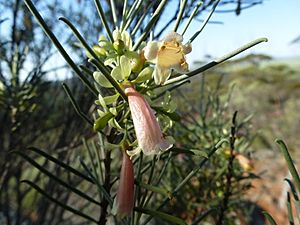Weeooka facts for kids
Quick facts for kids Weeooka |
|
|---|---|
 |
|
| Subspecies angustifolia near Wongan Hills | |
| Scientific classification | |
| Genus: |
Eremophila (plant)
|
| Species: |
oppositifolia
|
| Synonyms | |
|
|
The Weeooka (scientific name: Eremophila oppositifolia) is a special plant from Australia. People also call it the twin-leaf emu bush or mountain sandalwood. It belongs to the figwort family of plants.
This plant can be a bush or a small tree. Its leaves grow in pairs, one across from the other. Weeooka plants have beautiful flowers that can be cream, pink, red, or even a dark maroon color. You can find weeooka in all parts of mainland Australia, except for the Northern Territory.
Contents
What Weeooka Looks Like
The weeooka plant is usually a bush or a small tree. It can grow to be about 1 to 5 meters (3 to 16 feet) tall. Sometimes, it can even reach up to 10 meters (33 feet) high!
Its branches, leaves, and flower stalks are covered with tiny, soft hairs. These hairs lie flat against the surface. The branches can feel a bit rough because of old leaf bases that stay on them. As the plant gets older, the branches might become smooth.
The leaves grow in pairs on the branches. They are long and thin, almost like a cylinder. Many leaves have a small hook at their end. They are usually 29 to 120 millimeters (1 to 4.7 inches) long and 0.9 to 7 millimeters (0.04 to 0.3 inches) wide. Young leaves also have tiny yellowish glands on their underside.
Weeooka Flowers
Weeooka flowers grow alone or in small groups of up to four. They appear where the leaves meet the stem. Each flower sits on a hairy stalk that is 3 to 10.5 millimeters (0.1 to 0.4 inches) long.
Each flower has five hairy, spoon-shaped parts called sepals. These sepals are usually 7 to 18 millimeters (0.3 to 0.7 inches) long. They are often cream-colored or brown.
The petals of the flower are mostly 20 to 30 millimeters (0.8 to 1.2 inches) long. They join together at the bottom to form a tube shape. This tube can be cream with a hint of pink, or it can be pink, red, or sometimes maroon. The outside of the tube is smooth, but the inside is hairy. There are four stamens (the parts that make pollen) that stick out a little from the end of the petal tube.
Weeooka plants usually flower from winter to early summer. After the flowers, small fruits grow. These fruits are oval or cylinder-shaped and are 4 to 7 millimeters (0.16 to 0.28 inches) long.
Plant Names and Types
The first official description of the weeooka plant was written in 1810. It was published by a botanist named Robert Brown.
The scientific name oppositifolia comes from two Latin words. Oppositus means "on the other side" or "contrary." Folia means "leaves." This name describes how the leaves grow in opposite pairs on the plant.
There are three main types, or subspecies, of weeooka:
- Eremophila oppositifolia subsp. oppositifolia: This type has leaves that are almost round like a cylinder. They might be a bit flat or grooved on the bottom. These leaves are 1 to 3 millimeters (0.04 to 0.12 inches) wide.
- Eremophila oppositifolia subsp. angustifolia: This type has leaves that are cylindrical and firm. They stand upright and are also 1 to 3 millimeters (0.04 to 0.12 inches) wide.
- Eremophila oppositifolia subsp. rubra: This type has flat leaves that are wider, about 3 to 7 millimeters (0.12 to 0.28 inches) wide.
Where Weeooka Grows
Each subspecies of weeooka grows in different areas:
- Subspecies oppositifolia is common in South Australia, New South Wales, and Victoria. It grows in clay-loam soil in woodlands and shrublands.
- Subspecies angustifolia is common in Western Australia. You can also find it in a few places in South Australia. It grows in different types of soil in mulga and Eucalyptus woodlands.
- Subspecies rubra grows from western Queensland to central New South Wales. It usually grows in woodlands.
Growing Weeooka in Gardens
The weeooka plant is great for gardens because it has attractive leaves. Its colorful sepals also make it look nice for a long time. It can be a beautiful plant on its own. You can also use it as a windbreak or a screen to block views.
It's easy to grow new weeooka plants from cuttings. The plant can grow in many different kinds of soil, even clay. It likes full sun or a little bit of shade. Weeooka can handle long dry periods, but giving it water sometimes will help it flower better. It can also survive light frosts without damage. However, very cold frosts might make it lose its leaves.
Conservation Status
The Western Australian Government says that weeooka is "not threatened." This means there are plenty of these plants in the wild.
Images for kids
-
Subspecies angustifolia near Meekatharra
See also
 In Spanish: Weeooka para niños
In Spanish: Weeooka para niños



